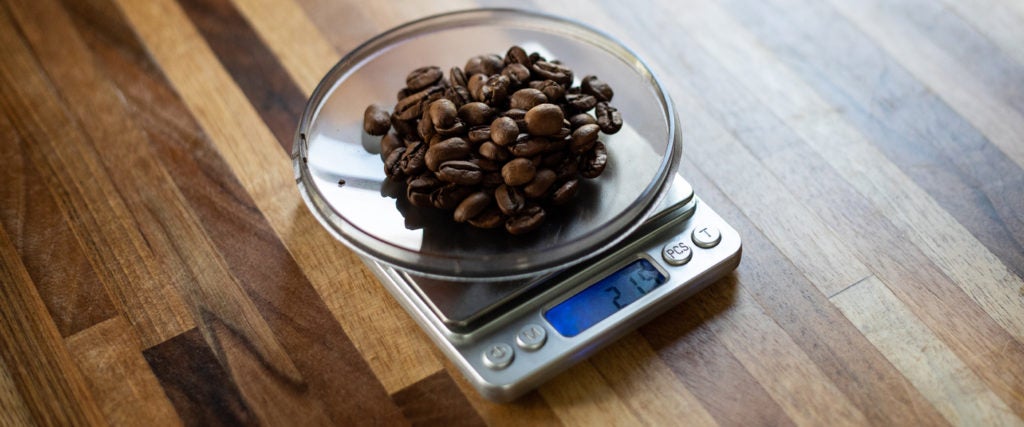I went on a run for coffee the other day, to one of those boutique roasters in San Francisco that charge $25 for a pound of beans and use adjectives like “blackberry jam” to describe how it tastes.
As if to prove the point, my own request for a 12-ounce bag of Los Gigantes beans led to a polite, but loaded, question in response: “What are you using to brew this?”
“A Hario V60,” I replied confidently.
She disappeared, then reemerged with a bright orange bag and a postcard full of fine print. On it were detailed instructions on how to use my little Hario pour-over cone to perfection. “V60 for 1: 15 grams of coffee to 250 grams of water. For two, 25 grams of coffee to 380 grams of water,” it read.
The instructions ran on, routinely requiring exact masses of water. “Add 60 grams of water to ‘bloom’ the coffee grounds,” it dictated. “At 45 seconds, add 140 grams of water, pouring in gentle concentric circles, from the center to the outside.”
I could see my girlfriend’s eyeballs rolling back into the darkness of her brain cavity as she peered through the instructions. “Who is really doing this?” she muttered to me. “It requires a gram scale.”
She already knew that pleading this case with a sarcastic dismissal was a lost cause. Why? Because I am really doing it with a gram scale, and to be frank, it’s transformed how good my morning coffee tastes. Hers, too, for that matter. Top coffee experts and baristas use gram scales because it’s the best way to dial in the ratios for a perfect cup. I have far lesser ambitions — learning to brew by weight has helped me figure out what attributes I enjoy about coffee, and how to coax those flavors out consistently.
It seems a little overkill, given that finding a gram scale in the kitchen sounds like something a cop would use as probable cause. But its popularity has rocketed in the last few years, buoyed first by Michelin-star chefs and competition baristas and later by geeky home cooks — the kind who love Good Eats and recognize the name “Harold McGee.” Now that cooking scales are more ubiquitous and affordable than ever, it’s time everyone adds one to their toolbox.
“But wait a second,” you retort. “I’ve never used a gram scale, and my [insert foodstuff here] came out just fine!”
That used to be me. Then I burst through the facsimile of the Matrix and realized, with horror, that two identical-looking, measured-out cups of flour can have a 28 percent difference in mass when weighed. Imagine if you were making pancakes, and Gordon Ramsay walks by and says, “You donkey, you’ve added 28 percent too much flour!” The horror! Now apply that horror to every from-scratch banana bread being made in households across America.
The impact is even more noticeable if you’re talking intensely flavored ingredients like coffee, tea or spices. While we mythologize the ability to just grab a pinch of this and that and create an incredible meal seemingly on feel alone, the reality is that consistency and good instincts come from doing something right over and over again. Using a scale lets you hone that ability with more control, and over time teaches you how to improvise with precision.
While I was being glib with that Matrix reference earlier, it really does feel like you’re a redpilled Neo when you finally start to understand how ratios govern all cooking. When you translate a recipe into the streamlined measurement of grams, the proportion of one thing to the other becomes far clearer — and that helps me better understand why dishes turn out the way they do, whether it’s a pie crust or a marinade.
Beyond doing wonders for your dough and baking needs (how about cheater baguettes and hand-pulled noodles?), a kitchen scale is useful for quickly making cocktails without needing to juggle various jiggers. You can troubleshoot old recipes by weighing ingredients out. A kitchen scale can help you portion more quickly, whether you’re rolling Italian meatballs, cutting single-serving steaks from a big Costco roast or just prepping healthy lunches in Tupperware. It can even help limit the number of dirty dishes, since you can just add ingredients directly into one main vessel rather than pulling out a variety of measuring spoons and cups.
There are a lot of opinions on the best model to buy; I’ve used a $45 stainless-steel OXO for years, but the cheaper Escali is a favorite, too. This is assuming you want a bigger scale that can handle a heavy bowl but is less precise. You might prefer a smaller, but more precise scale that measures tenths of a gram if you’re super-focused on coffee and, uhh, other powdered goods.
Remember, all that being said, a love of the scale doesn’t mean you have to be tied to it forever. I don’t use a gram scale for coffee most mornings anymore, after all. Turns out, I have a good idea now what 60 grams of water hitting 15 grams of coffee looks like! It’s also overkill for recipes that, by their nature, don’t benefit from high precision; I would discourage anyone from scaling the ingredients for, say, French onion soup.
For everything else, the trusty digital kitchen scale is here, willing and able to revolutionize the way you see cooking — or maybe just fix your cookie recipe, once and for all.

